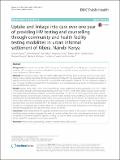Uptake and Linkage into Care Over One Year of Providing HIV Testing and Counselling through Community and Health Facility Testing Modalities in Urban Informal Settlement of Kibera, Nairobi Kenya
View/
Publication Date
5/4/2016Type
Article, Journalviews
downloads
Metadata
Show full item recordCitation
Muhula, S., Memiah, P., Mbau, L. et al. Uptake and linkage into care over one year of providing HIV testing and counselling through community and health facility testing modalities in urban informal settlement of Kibera, Nairobi Kenya. BMC Public Health 16, 373 (2016). https://doi.org/10.1186/s12889-016-3033-x
Abstract/
Background: We examine the uptake of HIV Testing and Counselling (HTC) and linkage into care over one year of providing HTC through community and health facility testing modalities among people living in Kibera informal urban settlement in Nairobi Kenya. Methods: We analyzed program data on health facility-based HIV testing and counselling and community- based testing and counselling approaches for the period starting October 2013 to September 2014. Univariate and bivariate analysis methods were used to compare the two approaches with regard to uptake of HTC and subsequent linkage to care. The exact Confidence Intervals (CI) to the proportions were approximated using simple normal approximation to binomial distribution method. Results: Majority of the 18,591 clients were tested through health facility-based testing approaches 72.5 % (n = 13485) vs those tested through community-based testing comprised 27.5 % (n = 5106). More clients tested at health facilities were reached through Provider Initiated Testing and Counselling PITC 81.7 % (n = 11015) while 18.3 % were reached through Voluntary Counselling and Testing (VCT)/Client Initiated Testing and Counselling (CITC) services. All clients who tested positive during health facility-based testing were successfully linked to care either at the project sites or sites of client choice while not all who tested positive during community based testing were linked to care. The HIV prevalence among all those who were tested for HIV in the program was 5.2 % (n = 52, 95 % CI: 3.9 %–6.8 %). Key study limitation included use of aggregate data to report uptake of HTC through the two testing approaches and not being able to estimate the population in the catchment area likely to test for HIV. Conclusion: Health facility-based HTC approach achieved more clients tested for HIV, and this method also resulted in identifying greater numbers of people who were HIV positive in Kibera slum within one year period of testing for HIV compared to community-based HTC approach. Linking HIV positive clients to care proved much easier during health facility- based HTC compared to community- based HTC.
Further Details
Open Access This article is distributed under the terms of the Creative Commons Attribution 4.0 International License (http://creativecommons.org/licenses/by/4.0/), which permits unrestricted use, distribution, and reproduction in any medium, provided you give appropriate credit to the original author(s) and the source, provide a link to the Creative Commons license, and indicate if changes were made. The Creative Commons Public Domain Dedication waiver (http://creativecommons.org/publicdomain/zero/1.0/) applies to the data made available in this article, unless otherwise stated.
Publisher
BioMed CentralISSN
1471-2458Collections
- General - GEN [367]

